Friends of San Ramon Creek Co-Chair Recognized for Exemplary Leadership in Watershed Conservation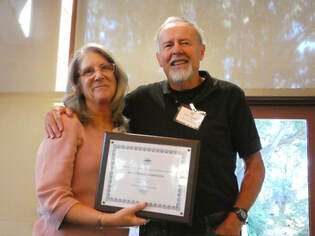 Danville, CA — At the 2023 Contra Costa County Creek and Watershed Symposium, a well-deserved spotlight shone on Dick Heron, Co-Chair of the Friends of San Ramon Creek, who was honored with the prestigious Watershed Champion Award. The accolade pays tribute to individuals who have demonstrated remarkable dedication, leadership, and partnership-building in the protection, restoration, and enhancement of local creeks and watersheds. Heron's contributions to the Friends of San Ramon Creek have been nothing short of extraordinary. With unwavering enthusiasm and dedication, he has been instrumental in leading various efforts within the group, furthering the cause of preserving San Ramon Creek and its watershed. Among his significant contributions, Heron has organized presentations as part of the Danville Library speaker series, spreading awareness about the importance of watershed health. He has also played a pivotal role in the group's water quality monitoring program, which is vital for understanding and preserving the local environment. However, one of the most outstanding and ongoing initiatives spearheaded by Dick Heron is the eradication of the invasive weed, Arundo donax, from the San Ramon Creek subwatershed. Recognizing the magnitude of the task at hand, Heron took the initiative in 2013, leading volunteer groups in removing Arundo from several areas along the creek in Danville. What sets Dick Heron apart is his forward-thinking approach. He collaborated with a software expert to develop a comprehensive map, meticulously tracking the locations of Arundo within the subwatershed. This strategic move laid the foundation for a highly organized and effective eradication effort. Through the challenges posed by each passing year, Dick Heron and the dedicated volunteers of Friends of San Ramon Creek have honed their removal methods to maximize efficiency. They meet every Friday from April through October, tirelessly working to remove Arundo from the creek banks. Thanks to Heron's strong leadership, the Friends of San Ramon Creek have successfully eradicated a remarkable 120,000 square feet of the known 160,000 square feet of Arundo in the San Ramon Creek subwatershed. Heron's dedication goes beyond the hands-on work. He ensures the volunteer team is equipped with all necessary permits, landowner permissions, and the required equipment for their weekly efforts. Furthermore, he keeps regulatory agencies well-informed about the progress of the eradication effort. The impact of Dick Heron's work extends far beyond the removal of invasive species. His leadership has served as a source of inspiration, motivating people to collaborate towards healthier watersheds in Contra Costa County. The recognition and honor bestowed upon him as the 2023 Watershed Champion reaffirms the tremendous value of his contributions. In response to the award, Heron expressed his gratitude and emphasized the importance of collective efforts in preserving the region's watersheds. He continues to serve as an inspiration to residents of Danville and beyond, reminding us all of the difference one person can make in the pursuit of a healthier and more sustainable environment. Congratulations, Dick Heron! Do you enjoy San Ramon Creek? Want to learn more about the creek & how you can help protect it?
The Friends of San Ramon Creek is hosting an informational meeting in Danville on Wednesday, June 15 at 5:30 pm in the Mt. Diablo Room of the Danville Public Library. The meeting is for everyone with an interest in our local creeks and who want to get involved in keeping them healthy. The featured speaker is Malcolm Sproul, who will provide tips about creek stewardship and flora, especially plants that stabilize, enhance the creeks and provide important habitat. He’ll also share stories about observed changes in our creek system over the decades and the biggest threats to a healthy watershed at this time. Malcolm received his B.A. and M.L.S. in Environmental Planning, from UC Berkeley, and then worked for the Marin County Planning Dept. for four years. In 1979, he joined LSA Associates and is now a principal in natural resources management and environmental planning, managing their Point Richmond office. An avid outdoorsman, Malcolm serves on the board of Save Mount Diablo and lives with his wife Casey live in Moraga. In 2020, Malcolm received Save Mount Diablo’s Mountain Saver Award and Diablo Magazine’s Threads of Hope Award. The Friends of San Ramon Creek is a grassroots organization whose mission is to support programs and projects which promote a healthy San Ramon Creek. Come learn about your local creek and get involved! For more information contact: Elizabeth Harvey Roberts [email protected] At the March 1st Board of Supervisors virtual meeting, the Supervisors unanimously signed a proclamation recognizing the Friends of San Ramon Creek, Walnut Creek Watershed Council, Contra Costa Fish and Wildlife Committee, and the volunteers.
Two of the hardworking volunteers, Mike Anciaux of Alamo and Dick Heron, a Danville resident, pictured here left to right with Supervisor Andersen, were instrumental in removing Arundo, an invasive non-native plant that consumes prodigious amounts of water, spreads aggressively, is a fire hazard, provides little in the way of habitat for animals, and can restrict creek flow. Dick and Mike were able to stop by Supervisor Andersen's Danville office and accept the proclamation in person. Use a Contractor to Remove Your Arundo and FSRC Will Pay HalfIf you own land along the San Ramon Creek you may be one of the 74 properties known to have Arundo growing on your property, Friends of San Ramon Creek (FSRC) would like to help you eradicate this noxious weed from your property. FSRC is offering to share the cost of removal of your Arundo when you use a contractor to remove your Arundo and treat it with herbicide to keep it from coming back. You can use either a contractor that FSRC recommends or, if you have a contractor who can do it cheaper, then your own contractor. FSRC will pay 50% of the invoice after the removal and treatment. FSRC has limited funds, so this offer is good until this year's allotment of funds is exhausted. Arundo Is Invading our Creek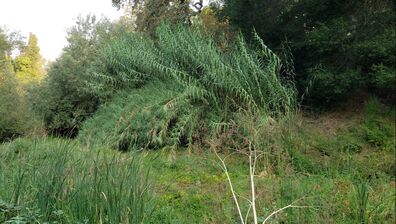 Arundo Crowds Out Everything Else Arundo Crowds Out Everything Else Arundo (Arundo donax) is a non-native invasive plant with stems that resemble bamboo and leaves that resemble corn. Also called "giant reed" or "giant cane," Arundo is a fast-growing plant that can grow four inches a day and up to thirty feet tall. To sustain its rapid growth, Arundo consumes prodigious amounts of water, usually along streams and other waterways. It outcompetes native plants and provides little food or habitat for insects, birds, or other wildlife.  74 Stands of Arundo in San Ramon Creek 74 Stands of Arundo in San Ramon Creek Arundo is taking over sections of the San Ramon Creek between Danville and Alamo. To date, Friends of San Ramon Creek (FRSC) has mapped 131 stands covering approximately 118,000 sq. ft. in the San Ramon Creek watershed. Over the last 7 years FSRC has treated 35 of these patches. There remain 96 patches covering 87,000 sf on 74 different parcels, almost all on private properties. If we don’t stop it, the banks of the creek will be monoculture Arundo and will have much less biodiversity, more fire danger, less water, and more erosion caused by creek narrowing and diversion. Removing Arundo Is Hard Work But It Can Be Successful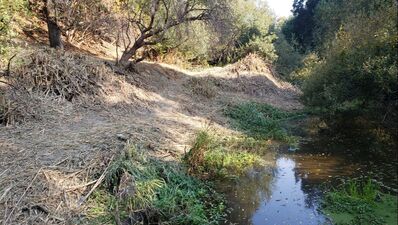 Arundo is typically eradicated by cutting the stalks and hauling them away and immediately treating the stumps with an herbicide to prevent regrowth. Arundo will have some regrowth after this treatment and will require monthly retreatment for several years to kill all of the plant. FSRC has been removing patches of Arundo for 7 years and has refined techniques that make this arduous job as simple as possible. 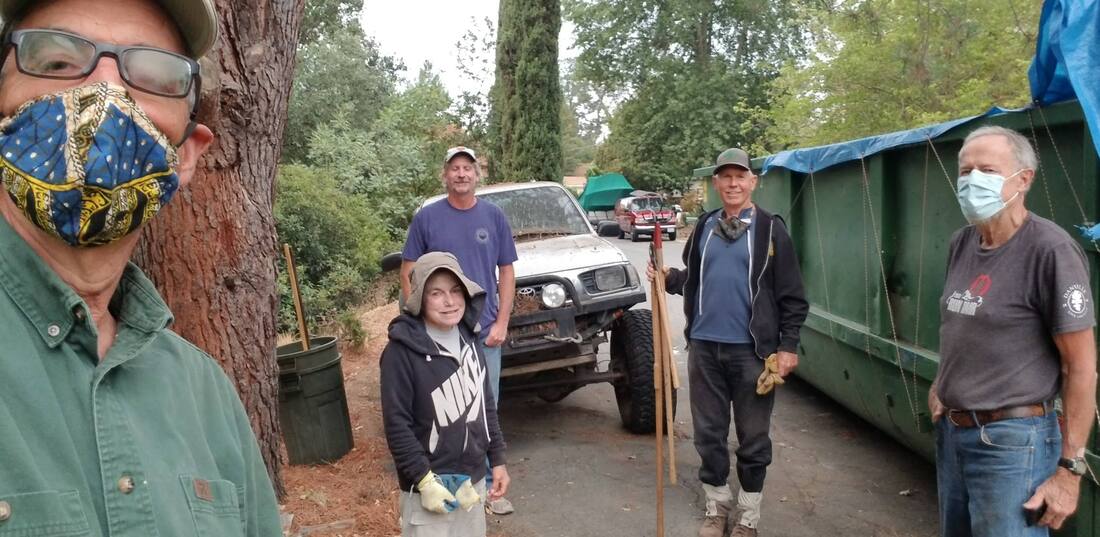 Each Thursday morning, for the last seven weeks, a group of four to six Friends of San Ramon Creek (FSRC) volunteers met in the Whitegate/Cameo area of Danville to remove four stands of Arundo from the Green Valley Creek watershed. Two of the four stands were quite large and very dense. It was hard work but the Arundo has been removed, the rhizomes treated with an herbicide and the rhizome area covered with a geotextile to kill the rhizomes by solarizing (baking) them. There are over 100 stands of Arundo in the San Ramon Creek subwatershed; most of them are on private property. FSRC is working to develop ways to work with property owners to remove these stands. This particular group of stands was chosen because iit provided an opportunity to test an approach to working with property owners and their neighbors and because is one of the furthest upstream stands. Working With Private Property Owners The project started with visits by a volunteer to get permission from the property owners to remove the Arundo. In this case, there were four properties with Arundo; one owned by a Homeowners Association and three owned by homeowners. One of the volunteers met with each of the property owners and explained the issue with Arundo in the creek and described the process to remove it. It took several visits with each property owner to get agreement to the plan for removal, treatment and maintenance. The volunteer then visited with all surrounding property owners to let them know what was happening so they were not surprised. One of the homeowners was insistent that we not use glyphosate. Small Group of Workers Can Socially Distance On July 31 the volunteers started attacking the stands one by one. With these large stands it was possible to keep five or six volunteers working and still stay socially distant. In each case a chain saw was used to quickly cut the stalks. The stalks were moved out of the way and piled into large, orderly, piles nearby. We tried not to use bucket brigades to move the canes but depended on a contractor to haul large piles up the hill and to the dumpster. De-duffing Needed To Treat Stumps When the stalks from a stand had been removed the team went back and de-duffed the stand. The volunteers used small rakes and hands to remove the leaves, dead stalks and other material that covered the ground between the stumps. The goal was to see the ground between the stalks. This effort was significant. It took about ⅓ of the time that it took to remove the stalks just to de-duff it. The duff was piled up near the stand and left to compost in place. Treated Stumps With Weedslayer After de-duffing, the stumps were recut with a chainsaw as close to the ground as practical. Then a volunteer painted each of the cut stumps with a highly concentrated herbicide (50% water, 50% Weedslayer or Roundup custom). Weedslayer Seems To Work On Stumps  Since the stands were treated over a period of six weeks or so and with different herbicides we were able to see the different impact of the herbicides.
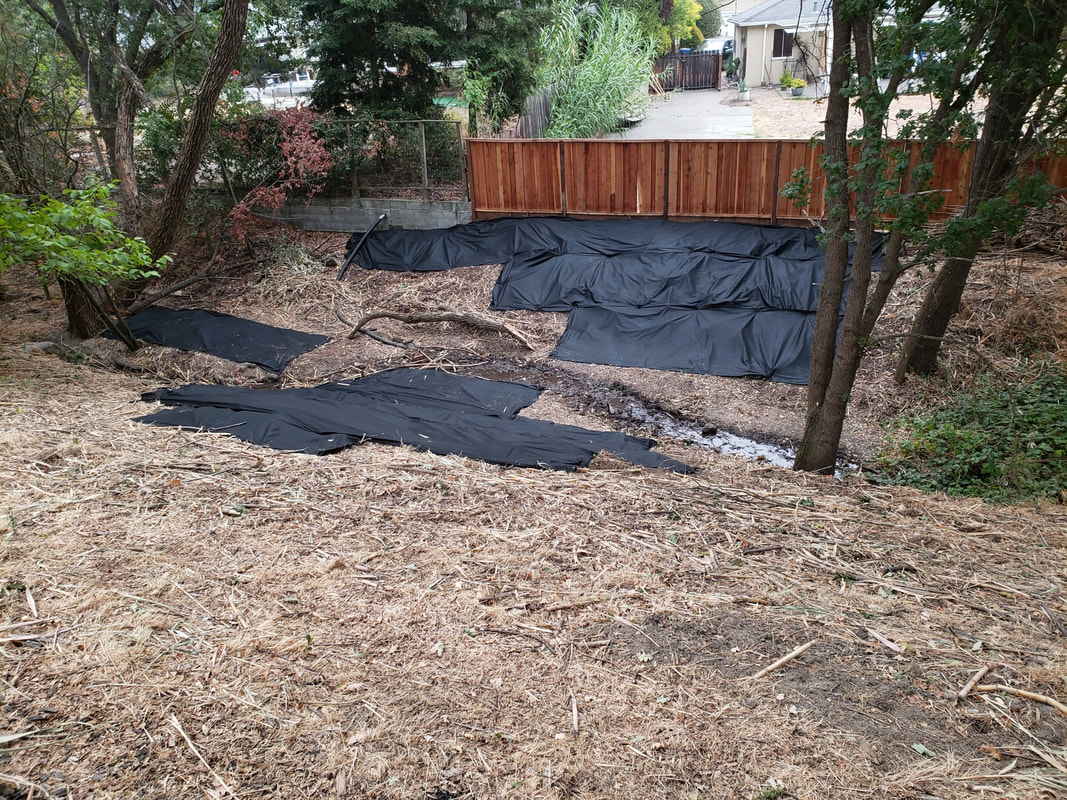 The final part of the treatment was another experiment by FSRC. A geotextile material was cut and laid over the exposed rhizomes and was attached to the ground with long staples. It is hoped that the black material will absorb heat and kill the rhizomes. We are unsure if this technique will work, how long it will take and whether aggressive growth will damage the geotextile. We anticipate leaving the geotextile in place for a year to maximize the effect. Contractor Hauled Stalks and Chipped Into Dumpster 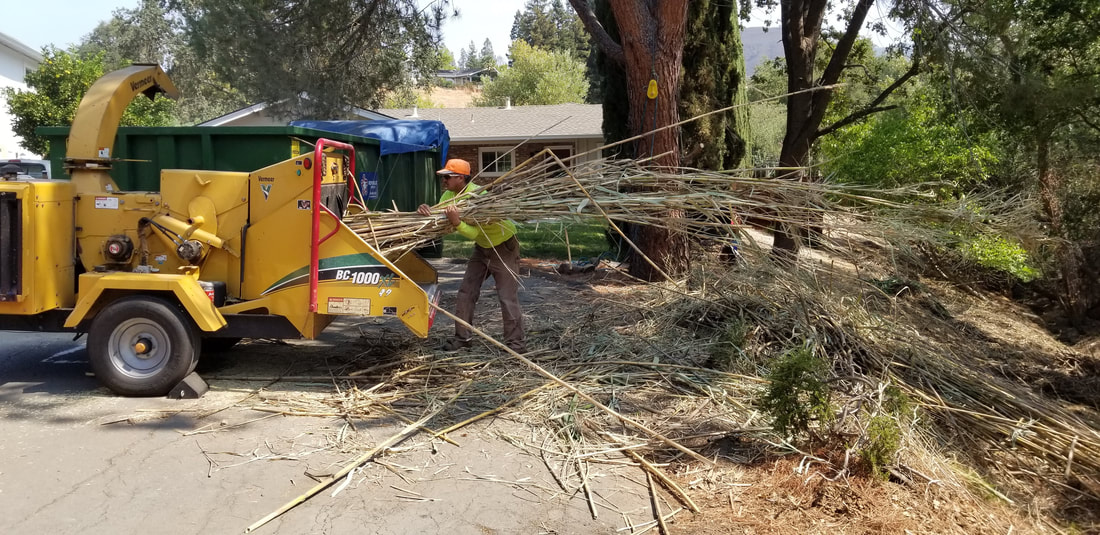 The piles of stalks were huge, maybe six feet around. They would have filled several dumpsters if we had put them in unchipped. In order to minimize the number of dumpsters required FSRC hired a contractor to haul the stalks to a dumpster and chip them into the dumpster. This seemed to reduce the volume needed to be hauled by ¾ or more. The contractor was able to save a lot of labor by dragging the bundles from the staging area near the stand to the dumpster. A rope was cinched around the bundle of stalks; the other end of the rope was tied to a truck and the truck pulled the pile up next to the chipper. For more information about this Arundo removal project contact Mike Anciaux at [email protected]. There are over 110 patches of Arundo in the San Ramon Creek Watershed. In 2019 Friends of San Ramon Creek started treating about 10 of the patches and hope to work on another 10 or more in 2020. We are in the process of selecting the candidates for 2020 efforts using the following criteria
Join The Restoration Trust, Friends of San Ramon Creek, and the Contra Costa Resource Conservation District for a CA native planting event in Danville! We will be planting native plant plugs along a portion of San Ramon Creek in Hap Magee Park. Re-vegetating the creek with native plants makes it more difficult for non-native invasive plants to establish themselves, and it provides habitat and food for wildlife.
For this event, we are limiting registration to 30 volunteers, so sign up at https://tinyurl.com/danvilleplantingevent ASAP. We hope you'll join us! Date: Saturday, December 14, 2019 Time: 9:30 AM - 11:30 AM Location: 1025 La Gonda Way, Danville, CA 94526 (just north of the sand volleyball court) More Important Details:
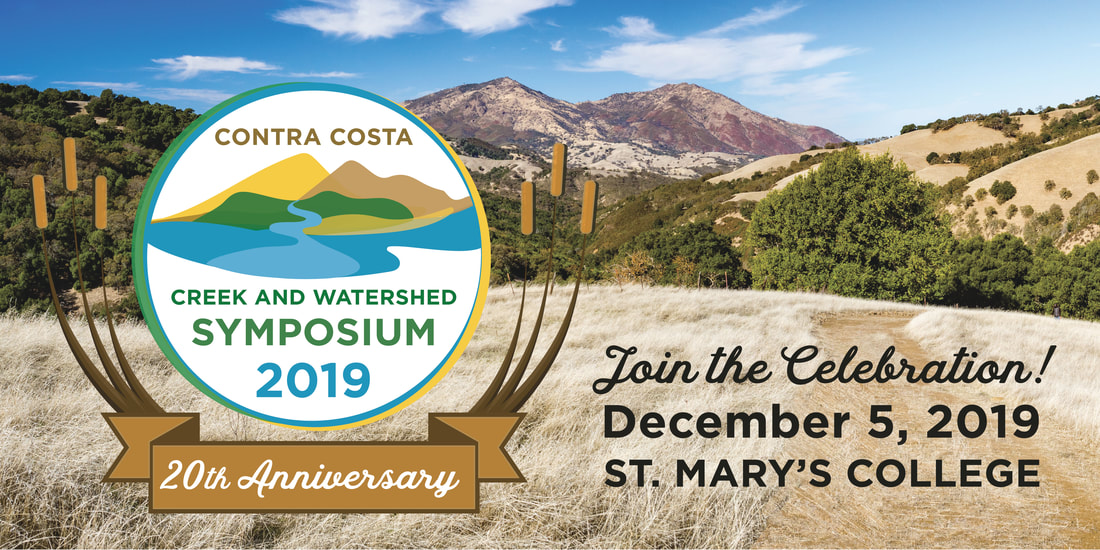 For 20 years the Contra Costa Watershed Symposium has connected people working to preserve their creeks and watersheds. Celebrating achievements and milestones, while providing a supportive network for members to learn and network. This year’s Symposium will host a number of speakers exploring the themes of innovation, inclusion, and the legacy of the Symposium. Keynote speakers: Obi Kaufmann, author of California Field Atlas and the State of Water Eben Schwartz, California Coastal Conservancy Dr. Ana Alvarez, East Bay Regional Park District Register Now! 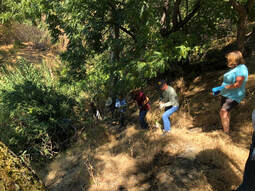 Monday, October 28 | 6:30 - 7:30 p.m Part of the Nature Series at the Danville Library Volunteers are eradicating Arundo throughout the San Ramon and Walnut Creek Watersheds. Arundo invades our streams and creates erosion and flooding problems. Get informed and sign up to help efforts to get rid of this invasive, fast growing plant and replace it with natives. 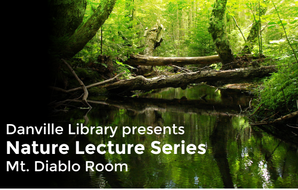 Monday, September 23 | 6:30 - 7:30 p.m Part of the Nature Series at the Danville Library Speakers from Contra Costa County Public Works will provide a program for creek owners on the care and maintenance of their creek property. The San Ramon Creek watershed covers 54 square miles and includes San Catanio, Sycamore, Green Valley, Rutherford and Stone Valley Creeks. It is part of the large Walnut Creek watershed. |
Walnut Creek Watershed Council
|
Copyright 2024 Walnut Creek Watershed Council. All Rights Reserved.
Many images courtesy of the Contra Costa Resource Conservation District. |


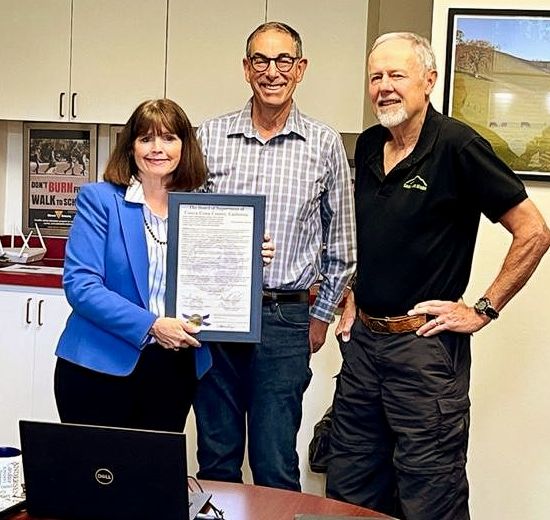
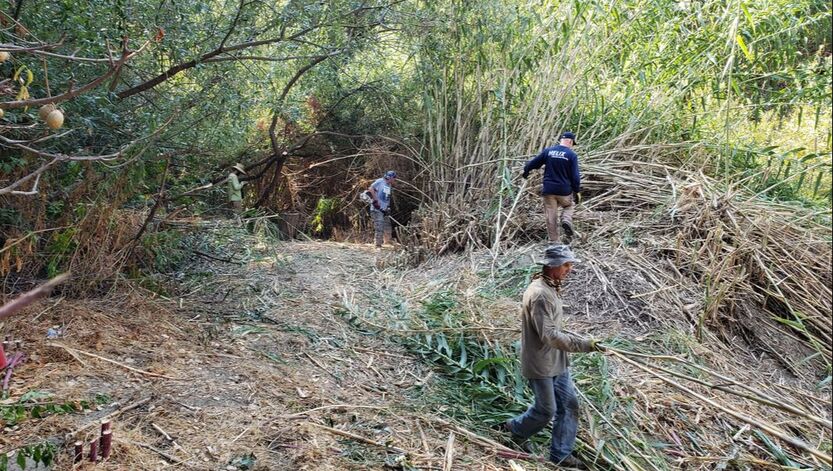
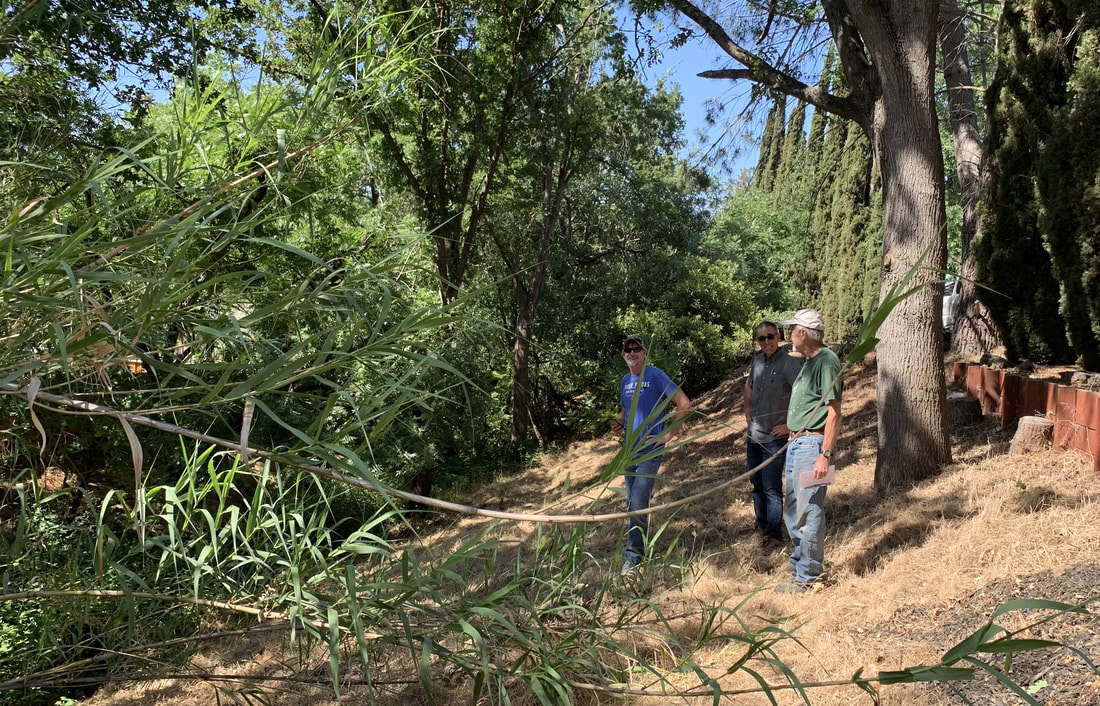


 RSS Feed
RSS Feed